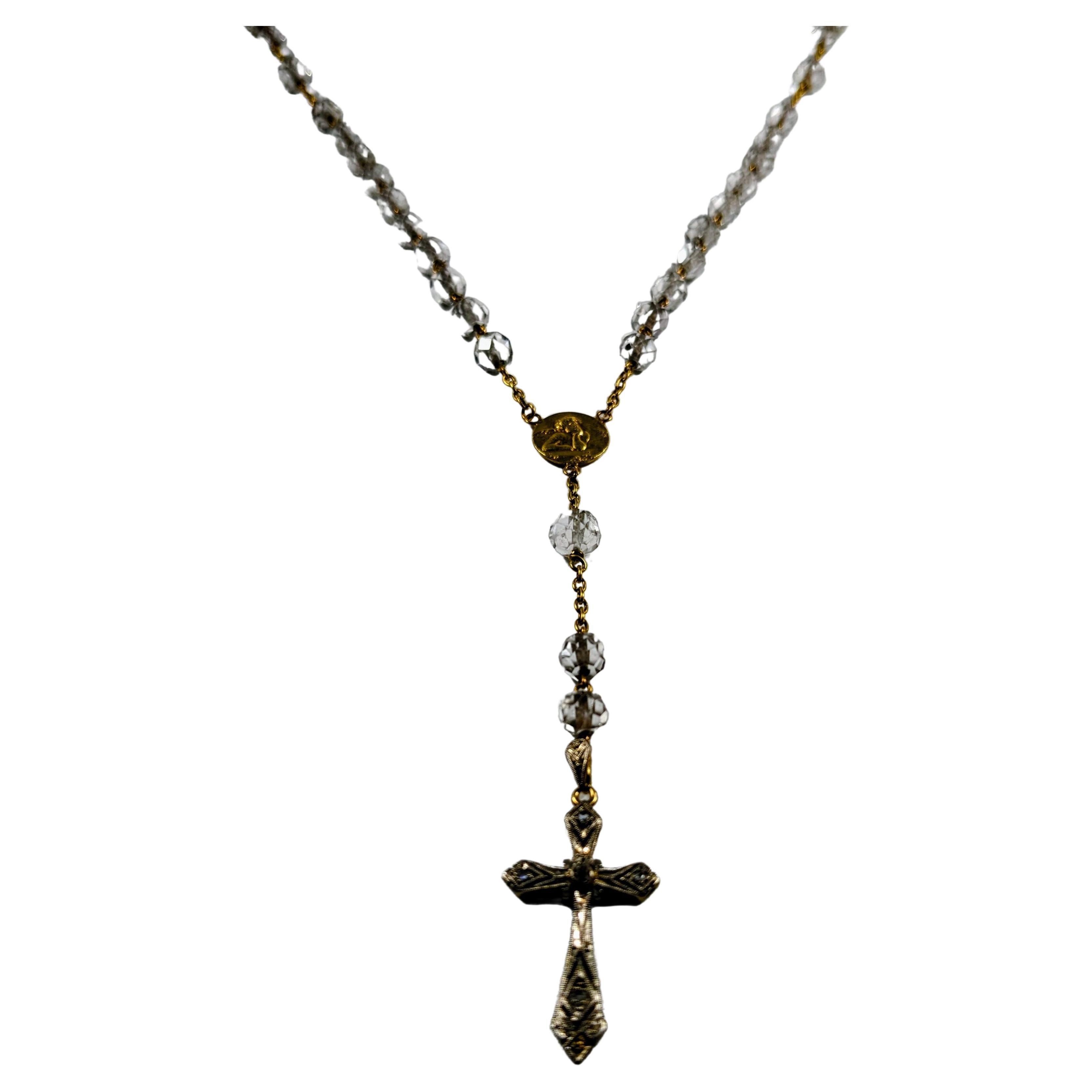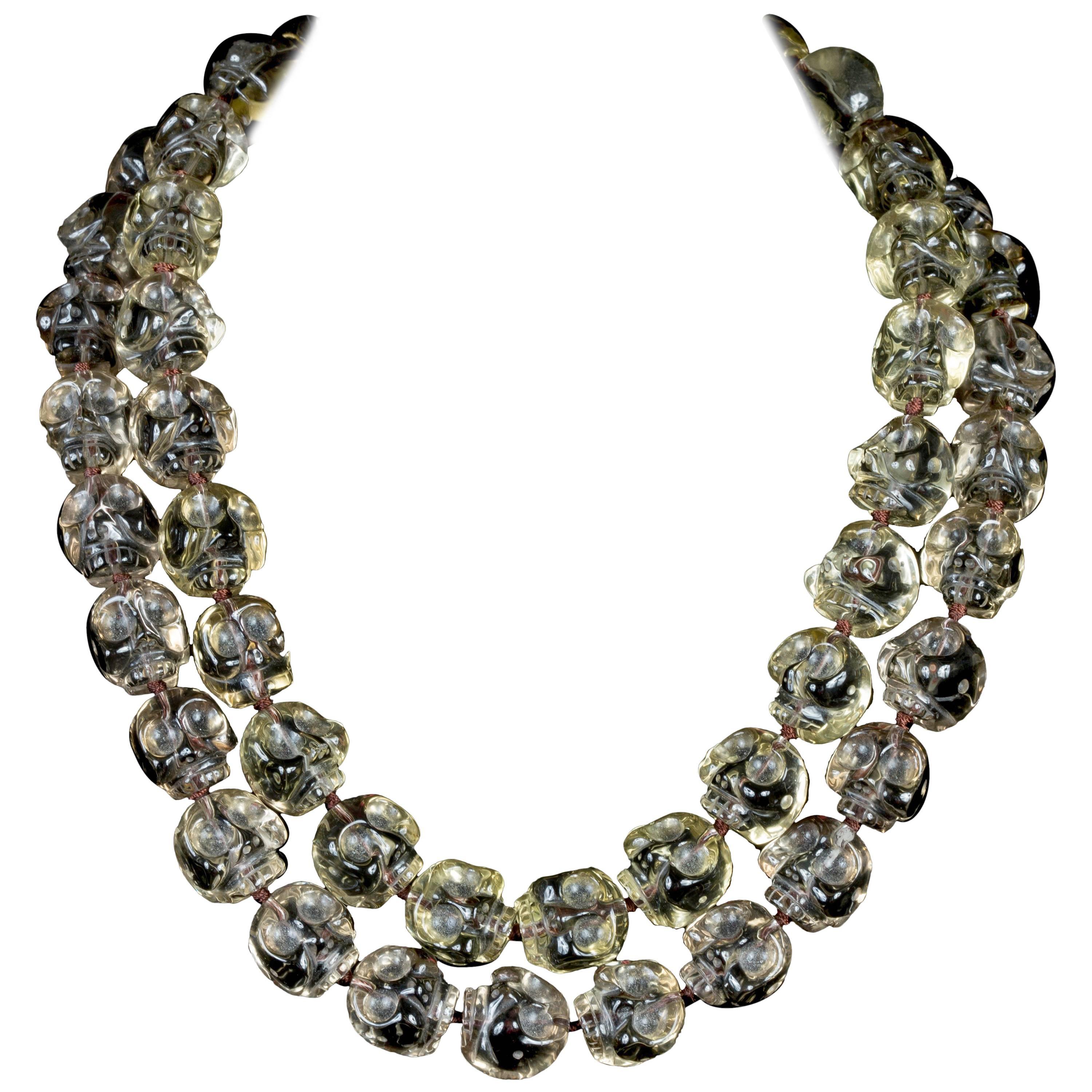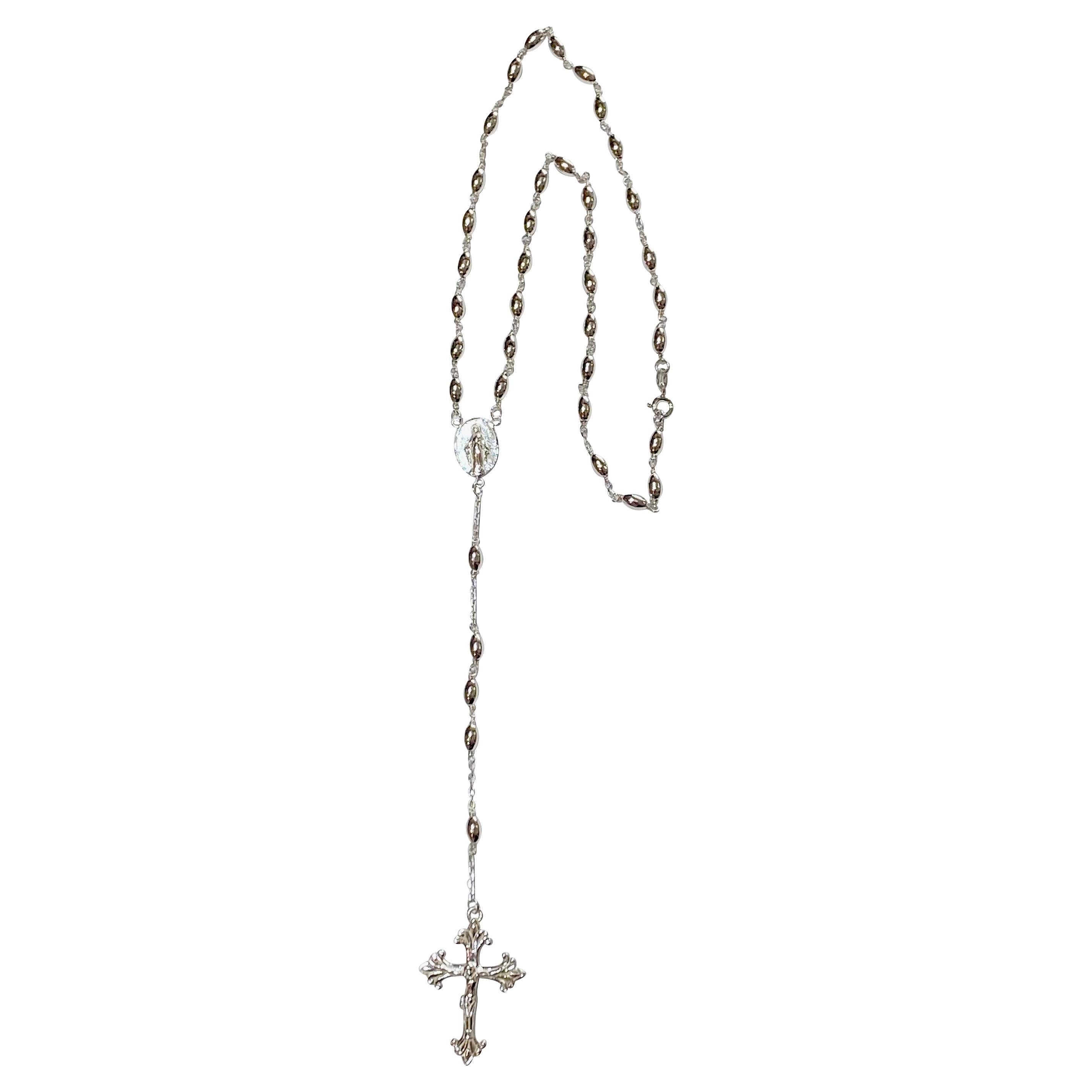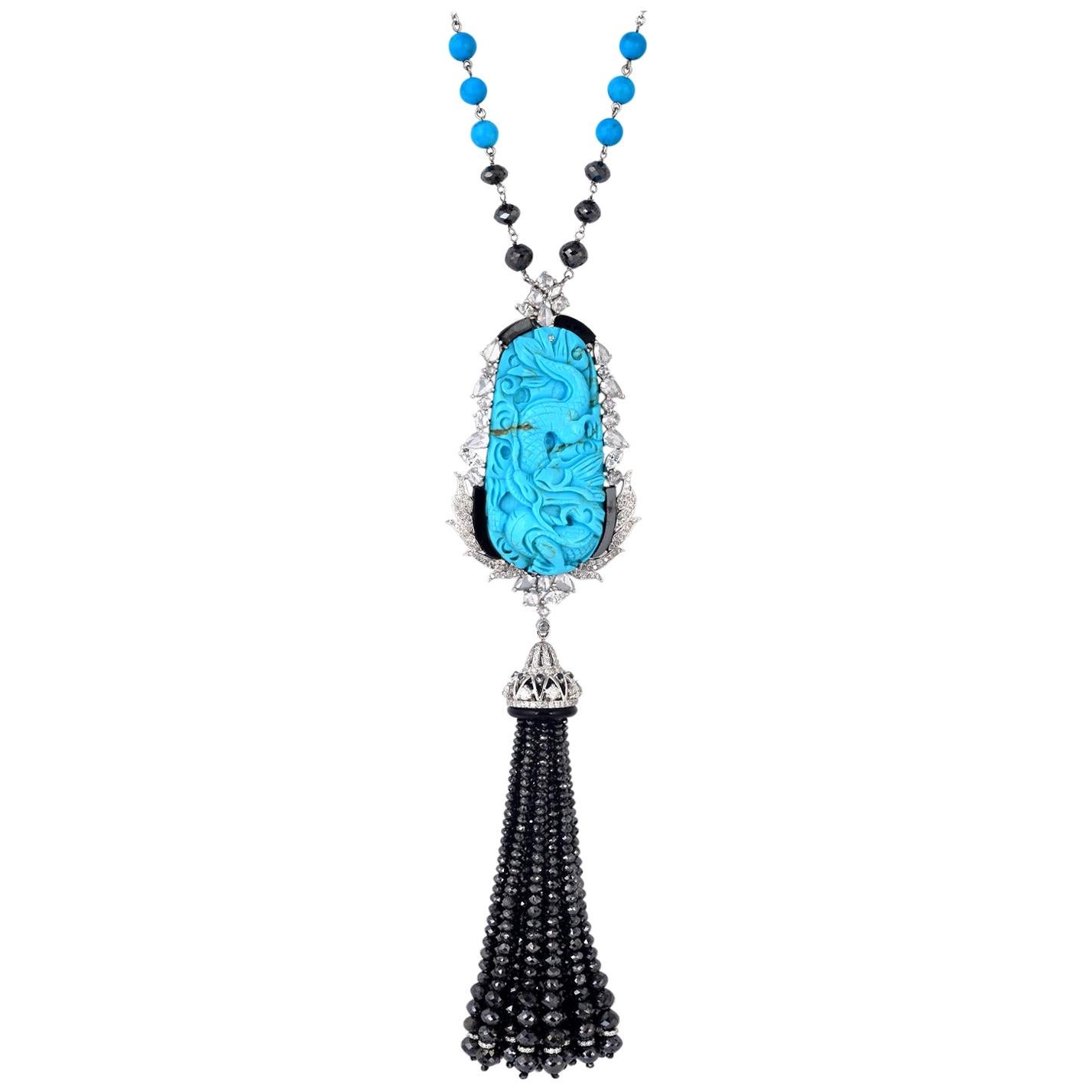Items Similar to Antique Double Sided Rosary Bead with Head of Christ and Skull Carved in Bone
Video Loading
Want more images or videos?
Request additional images or videos from the seller
1 of 12
Antique Double Sided Rosary Bead with Head of Christ and Skull Carved in Bone
About the Item
ROSARY BEAD WITH WENDEKOPF
Germany, 16th century
Bone
Weight 12 grams; dimensions 29 × 23 × 24 cm
A double-sided bead made of bone with a finely carved head of Christ on one side and a skull on the other side and with a vertical drillhole for threading onto a rosary.
Rosaries often had a larger, more lavish bead at the end of the string, the terminal bead, as well as so-called gauds—large, ornamental beads that prompted the devotee to say the Pater Noster. Because of its size, this bead might be either one of these bead types. Both of these types of larger beads signaled wealth and upper-class status manifested in fine materials and exquisite workmanship, but they also likely attest to their owners’ most deeply held concerns. More than seventy skull-shaped bone or ivory beads are preserved in museum collections.
The use of bone as a material has various associations and purposes; some Tibetan prayer beads were made of human skulls (extremely unlikely in this case!), but most medieval people would have believed ivory, from an elephant’s “tooth,” to be a kind of bone. At any rate, the use of bone would effectively magnify the association with death.
Stephen Perkinson calls the death’s head a “true mirror,” supplying a means of looking “that reveals the truth about us that lies hidden beneath our skin.” The imagery and objects that can be classed as memento mori (Latin: “remember that you must die”) might have reminded the onlooker of the transitory nature of life and material goods, or they might have served as warnings against vanity and an injunction against sin. On Ash Wednesday even today, Christians receive ashes marked onto their foreheads with the ritual words, “Remember, man, that you are dust, and unto dust you shall return.”
Within this context, double-sided prayer beads seek to activate thoughts about mortality. Called Wendekopf (revolving heads) in German, their very nature induced the onlooker to rotate them to see both—or three or four—sides. Many examples, such as a terminal bead from the Metropolitan Museum of Art, show a “portrait” of the elegantly dressed owner, only to reverse to the thought-provoking skull, or here a skeletal torso, crawling with the vermin of decomposition. (Compare the hardwood snuff box possibly meant to store tobacco that takes the shape of a skull and whose “vermin” turn into the snake of the story of Eden, the biblical origin of humanity’s mortality.) Rosary beads might show a newly married couple on one side and a skull or the ages of man on the other. Again, the impetus to turn the bead, to imaginatively move through time, is part of the devotional experience.
This bead diverges from the majority of the beads just described in that it lends itself more readily to devotional use. Three sixteenth-century German beads in Hamburg are similarly two-sided and similarly display the Face of Christ with the Crown of Thorns on one side, and a skull on the opposite side. Each of these objects urges the viewer to turn the bead. (Eager hands may in fact have been responsible for the damage on this bead.) In these two-faced beads, ultimately the owner does not enjoy looking at his own “portrait,” but instead must identify with the skull, an abject reminder of mortality that as the bead turns recalls the suffering of Christ’s incarnation and Passion. In a touching detail and perhaps final reassurance: although Christ does not meet the eyes of the viewer, his lips seem to be parted as if to speak.
- Weight:12 g
- Dimensions:Height: 1.15 in (29 mm)Width: 0.91 in (23 mm)Depth: 9.45 in (240 mm)
- Place of Origin:
- Period:16th Century
- Date of Manufacture:16th century
- Condition:Wear consistent with age and use.
- Seller Location:Chicago, IL
- Reference Number:
About the Seller
5.0
Vetted Seller
These experienced sellers undergo a comprehensive evaluation by our team of in-house experts.
Established in 1991
1stDibs seller since 2021
5 sales on 1stDibs
Typical response time: 13 hours
- ShippingRetrieving quote...Ships From: Chicago, IL
- Return PolicyA return for this item may be initiated within 3 days of delivery.
More From This SellerView All
- Fifteenth Century Reliquary Pendant with Christ on the CrossLocated in Chicago, ILReliquary Pendant with Christ on the Cross Germany, c. 1480–1500 Gilded silver Weight 35 grams; dimensions 69 × 46 × 8 mm A mixture of forms gives t...Category
Antique 15th Century and Earlier German Figurines and Sculptures
MaterialsSilver, Gilt Metal
- Antique Spanish Jet Amulet Pendant with FigaLocated in Chicago, ILAMULET PENDANT WITH FIGA Spain, c. 1620–1630 Jet, silver, and enamel Weight 60.7 grams; dimensions 85 × 49 × 18 mm Large pendant in the shape of a hand carved from jet with a clinched fist in the figa (Spanish higa) gesture. In the palm of the hand is a heart carved in relief and on the back a six-ray star in a circle. The silver mount covers the wrist like a cuff and is decorated with a frilled border, and on the front with collet-set bosses with silver C-scrolls against blue enamel; on the back is a roundel in relief with floral motif. Domed base for the pendant loop in pea-pod form. The figa (also fica or higa) represents an age-old symbol of protection against the evil eye and other demonic threats. Its origins were pagan and buried deep in antiquity. Roman examples, such as one found recently in an archeological excavation in London, also make it clear that the protective qualities are based in a sexual symbolism–particularly the power of the phallus. The Roman bone figa/phallus in effect represents the phallus twice; that is, the gesture made by the figa hand is generally explained as fingers representing the female genitalia (vulva) penetrated by the phallus of the thumb. But other interpretations are less specific, including explanations that the left hand is the feminine principle, and the right hand is the masculine. In Spain, jet figa are common; we see one in the portrait of Anne of Austria the infanta (p. 75). That is not to say that the objects are not sumptuous or treasured. Jet was a very valuable material, and in many examples like this one, the figa is embellished with beautiful enameling or is even gem-studded. Comparable objects occur in equally sumptuous materials such as rock crystal. The enameled setting allows a dating of these objects that otherwise might prove difficult, given that the production of such objects in Spain is so consistent over centuries. Indeed, there is another, even more elaborately carved example in this collection, attached to the “magic belt” (no. 9). That example may belong to an earlier group. That figa includes deeply excavated carving, including on the upper surface, an M-shaped design that Walter Leo Hildburgh links to the heart shape (as it occurs more explicitly on this example). Hildburgh argues that its presence is especially common on these objects and that it originally represented the Sacred Heart of Mary...Category
Antique Early 17th Century Spanish Pendant Necklaces
MaterialsSilver
- Antique Italian Cameo Hair Pin with Double Portrait of Cosimo I de MediciLocated in Chicago, ILCameo with Double Portrait of Cosimo I de Medici and Camella Martelli Cameo, Northern Italy, late 16th century; mount with pin 18th century and later Gold, onyx Weight 3.7 gr.; 14.88 mm. Two-layered onyx cameo (white on translucent pale brown) with jugate heads facing to the right looking upwards. The male head with short curly hair, beard and moustache wears a tunic draped around his neck and shoulders. The female head in the background has her hair tied back. They are cut in the white layer of the stone with translucent pale brown background. The cameo is convex on the reverse and open-set in a pendant with plain gold collet and rounded edges. A long gold pin is attached to the pendant loop and the opposite end has a section of coiled wire Literature: Portraits of Roman Emperors were popular and highly fashionable during the Renaissance period, rulers would often be portrayed like their ancient counterparts, also as a double portrait with spouse, or known as jugate heads. The individual features of the couple portrayed here suggest it could be a double portrait of Cosimo I de Medici (1519-1574) at a slightly older age and his second wife Camilla Martelli, Duchess Consort of Florence (1545-1590) whom he married in 1570. Bust sculptures of Cosimo de Medici in the Galleria Uffizi by Baccio Bandinelli...Category
Antique 16th Century Italian Renaissance More Jewelry
MaterialsOnyx, Gold
- Antique Spanish Hat Badge Pendant Carved in JetLocated in Chicago, ILBADGE WITH ST. JAMES THE GREAT Northern Spain, 16th century Silver, jet Weight 18.2 grams; dimensions 44 × 43 × 12 mm Round pendant with high-relief image of St. James the Great of Santiago de Compostela carved in jet. The saint is flanked by two pilgrims (their heads defaced); each holds a staff and rosary in his hand. Silver mount with plain flat backplate, corded wire surround and toothed edge as setting. Four pendant loops for sewing onto a hat or cloak. According to the Roman naturalist Pliny, jet, the material of which this pin was made, prevented snakebite and was “thrown up by the sea.” The first quality would certainly have been reassuring for a pilgrim who owned this object and who had to make long journeys over unfamiliar terrain. The second quality made jet an especially fitting material to honor St. James, given that his body arrived in Spain mysteriously, carried there “by the sea” from the Holy Land. Santiago de Compostela was a major center for jet carving from the late Middle Ages, and highly polished jet was a desirable and common material for pilgrimage souvenirs. One even finds scallop shells, the pilgrim’s badge...Category
Antique 16th Century Spanish More Objets d'Art and Vertu
MaterialsSilver
- Antique Gold Pendant with Diamonds and PearlsLocated in Chicago, ILPendant with Virgin Mary as Queen of Heaven Western Europe, Southern Germany (?), Italy (?), c. 1550-1560 Gold, enamel, diamonds, and pearls Weight 13.2 gr; Length 36.9 x 31.2 mm (incl. pearls) This sumptuous image exudes regal power. It portrays the Virgin Mary as Queen of Heaven wearing a dress and crown studded with seven large diamonds and set against a translucent, rich blue celestial background. Far removed from the tender, humble Virgin seen in German and Netherlandish artworks of the period, she is a majestic ruler, mouth sternly set, head tilted upward, and face in full profile. The oval pendant cast in high gold relief with a central medallion, the single figure filling the space, echoes jewelry portraits of the aristocracy during the Renaissance, which similarly offset the ruler’s image against a blue field composed of enamel or lapis lazuli, symbolic of divine power Only the rays of the shining gold halo that emerge behind the Virgin’s head and her long flowing hair (instead of neatly coiffed) distinguish her from female ruler portraits of the period. Three studded pearls, forming an axis, also recall pendants of European rulers. Wealth, royal status, and divine power come together in this opulent pendant. Portraits of the period show similar small oval pendants worn by women in the square of the garment or by men nestled inside multiple chains below the base of the neck. PROVENANCE European Private Collection LITERATURE Compare images from ancient Rome, for example a sardonyx cameo with female head (Kugel 2000, no. 18; Milan, c. 1550), and a pendant with gold, pearls, and enamel in the Staatliche Museum Kassel (Schmidberger/Richter 2001, no. 43; France, c. 1555-1560). For ruler pendants with blue backgrounds see a pendant of King Frances I...Category
Antique 16th Century Pendant Necklaces
MaterialsDiamond, Pearl, Gold
- Antique Gold Fede Gimmel Ring with Ruby and DiamondLocated in Chicago, ILGimmel Fede RIng with Inscription "GAGE D'AMITIE" Probably England, c. 1750 Gold, ruby and diamonds Weight 6.5 gr., US size 8.25, UK size Q ½ This gold ring...Category
Antique Mid-18th Century Engagement Rings
MaterialsDiamond, Ruby, Gold
You May Also Like
- Rosary Necklace in 18k Gold and OnyxLocated in Bilbao, ESRosary Necklace in 18K Gold and Onyx Rosary Necklace Unisex Woman Man with Virgin Mary Miraculous Medal and Cross 18kt rose gold with Onyx with brilliant and satin finish Weight: gr...Category
2010s Spanish Figurines and Sculptures
MaterialsOnyx, Gold, 18k Gold, Yellow Gold
- Rosary in Yellow Gold with Faceted Crystal and Cross in white gold and diamondsLocated in Bilbao, ESRosary in yellow gold with faceted crystal beads, a medal with an angel and an openwork cross in gold with diamonds, on views of white gold Length to the medal...Category
21st Century and Contemporary Spanish Artist Figurines and Sculptures
MaterialsCrystal, Gold, 18k Gold, Yellow Gold
- Beautifully Carved Smoky Quartz Skulls in Double Line NecklaceLocated in Nuevo Leon, MXBeautifully Carved Smoky Quartz Skulls in Double Line Necklace. Each skull was carved in Germany from a very fine Smokey Quartz, the clarity is immaculate...Category
21st Century and Contemporary German Beaded Necklaces
- Rosary Bead Necklace w Cross Handmade in Sterling Silver and LongBy Five Star JewelryLocated in Austin, TXThis beautiful rosary has a sterling silver bead for each prayer and a lovely cross at the bottom. The necklace is eighteen inches long and then has the Y and then the drop of the cr...Category
21st Century and Contemporary American Modern Beaded Necklaces
MaterialsSterling Silver
- Black Natural Diamond Beads 14k Gold Rosary NecklaceBy Emre OsmanlarLocated in ISTANBUL, TRThis necklace is handmade with 14K gold and bead cut diamonds. You can prefer it also with yellow/green diamonds.Category
21st Century and Contemporary Turkish Contemporary Beaded Necklaces
MaterialsBlack Diamond, Gold
- Carved Turquoise Necklace with Onyx and Turquoise Beads and Diamonds in GoldBy Artisan NYCLocated in New York, NYMake a hustle with this beautiful long hand Carved Turquoise Necklace. This necklace has turqoiuse and black onyx beads on white gold chain and h...Category
21st Century and Contemporary Indian Art Deco Drop Necklaces
MaterialsDiamond, Onyx, Turquoise, Gold, 18k Gold, White Gold
Recently Viewed
View AllMore Ways To Browse
Hidden Vanity
Large Antique Vanity
Antique Jewelry Display Cases
Antique Jewelry Display Case
Antique Jewlery Display Case
Antique Jewellery Display Case
Antique Mirrored Jewelry Box
Antique Mirror Jewelry Box
Carved Vanity Case
Ivory Necklaces
Beaded Snake
Antique Ash Can
Metropolitan Museum Of Art Jewelry
Metropolitan Museum Art Jewelry
Antique German Jewelry Box
Ivory Mirror Antique
Ivory Beaded Dress
Snake Mirror





